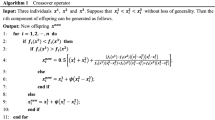Abstract
The uncertainty of a financial market is traditionally dealt with probabilistic approaches. However, there are many non-probabilistic factors that affect the financial markets. A number of empirical studies showed limitation of using probabilistic approaches in characterizing the uncertainty of the financial markets. Fuzzy set is a powerful tool used to describe an uncertain environment with vagueness, ambiguity or some other type of fuzziness, which are always involved in not only the financial markets but also the behavior of the financial managers' decisions. In a financial optimization model using fuzzy approaches, quantitative analysis, qualitative analysis, the experts' knowledge and the managers' subjective opinions can be better integrated. In this paper, we give an overview on the development of fuzzy portfolio selection to date. Some related problems that might deserve further investigations are also discussed.
Similar content being viewed by others
References
Bellman, R. and L. A. Zadeh. (1970). “Decision Making in a Fuzzy Environment,” Management Science 17, 141–164.
Deng, X. T., S. Y. Wang, and Y. S. Xia. (2000). “Criteria, Models and Strategies in Portfolio Selection,” Advanced Modeling and Optimization 2, 79–104.
Dourra, H. and P. Siy. (2001). “Stock Evaluation Using Fuzzy Logic,” International Journal of Theoretical and Applied Finance 4, 585–602.
Dubois, D. and H. Prade. (1988). Possibility Theory. New York: Plenum Press.
Fang, Y., K. K. Lai, and S. Y. Wang. (2001). “A Model for Portfolio Selection with Interval Coefficients,” submitted to Fuzzy Optimization and Decision Making.
Inuiguchi, M. and J. Ramik. (2000). “Possibilistic Linear Programming: A Brief Review of Fuzzy Mathematical Programming and a Comparison with Stochastic Programming in Portfolio Selection Problem,” Fuzzy Sets and Systems 111, 3–28.
Inuiguchi, M. and T. Tanino. (2000). “Portfolio Selection under Independent Possibilistic Information,” Fuzzy Sets and Systems 115, 83–92.
Heilpern, S. (1992). “The Expected Value of a Fuzzy Number,” Fuzzy Sets and Systems 47, 81–86.
Kataoka, S. (1963). “A Stochastic Programming Model,” Econometrica 31, 181–196.
Konno, K. and H. Yamazika. (1991). “Mean Absolute Deviation Portfolio Optimization Model and Its Application to Tokyo Stock Market,” Management Science 37, 519–531.
Lai, K. K., S. Y. Wang, J. H. Zeng, and S. S. Zhu. (2001a). “Portfolio Selection Models with Transaction Costs: Crisp Case and Interval Number Case.” In D. Li (ed.), Proceedings of the 5th International Conference on Optimization Techniques and Applications, Hong Kong, December, 943–950.
Lai, K. K., S. Y. Wang, J. P. Xu, S. S. Zhu, and Y. Fang. (2001b). “A Class of Linear Interval Programming Problems and Its Application to Portfolio Selection,” To appear in IEEE Transactions on Fuzzy Systems.
Leoń, T., V. Liern, and E. Vercher. (2000). “Fuzzy Mathematical Programming for Portfolio Management.” In M. Boilla, T. Casasus, and R. Sala (eds.), Financial Modelling. Heidelberg: Physica-Verlag, 241–256.
Leoń, T., V. Liern, and E. Vercher. (2002). “Viability of Infeasible Portfolio Selection Problems: A Fuzzy Approach,” European Journal of Operational Research 139, 178–189.
Liu, B. (2002). Theory and Practice of Uncertain Programming. Heidelberg: Physica-Verlag.
Mansini, R. and M. G. Speranza. (1999). “Heuristic Algorithms for the Portfolio Selection Problem with Minimum Transaction Lots,” European Journal of Operational Research 114, 219–233.
Markowitz, H. (1952). “Portfolio Selection,” Journal of Finance 7, 77–91.
Östermark, R. (1996). “A Fuzzy Control Model (FCM) for Dynamic Portfolio Management,” Fuzzy Sets and Systems 78, 243–254.
Parra, M. A., A. B. Terol, and M. V. R. Uría. (2001). “A Fuzzy Goal Programming Approach to Portfolio Selection,” European Journal of Operational Research 133, 287–297.
Peters, E. E. (1996). Chaos and Orders in the Capital Markets. New York: John Wiley & Sons Inc.
Philippe, J. (1997). Value at Risk: The New Benchmark for Controlling Derivatives Risk. McGraw-Hill.
Ramaswamy, S. (1998). Portfolio Selection Using Fuzzy Decision Theory, Working Paper of Bank for International Settlements, No.59.
Roy, A. D. (1952). “Safety-First and the Holding of Assets,” Econometrics 20, 431–449.
Saaty, T. L. (1980). The Analytic Hierarchy Process. New York: McGraw-Hill.
Sharpe, W. (1964). “Capital Asset Prices: ATheory of Market Equilibrium under Conditions of Risk,” Journal of Finance 19, 425–442.
Speranza, M. G. (1993). “Linear Programming Models for Portfolio Optimization,” Finance 14, 107–123.
Sturm, J. (1999). “Using SeDuMi 1.02, a MATLAB Toolbox for Optimization Over Symmetric Cones,” Optimization Methods and Software 11, 625–653.
Tanaka, H. and P. Guo. (1999). “Portfolio Selection Based on Upper and Lower Exponential Possibility Distributions,” European Journal of Operational Research 114, 115–126.
Tanaka, H., P. Guo, and I. B. Türksen. (2000). “Portfolio Selection Based on Fuzzy Probabilities and Possibility Distributions,” Fuzzy Sets and Systems 111, 387–397.
Tay, N. S. P. and S. C. Linn. (2001). “Fuzzy Inductive Reasoning, Expectation Formation and the Behavior of Security Prices,” Journal of Economic Dynamics & Control 25, 321–361.
Vandenberghe, L. and S. Boyd. (1996). “Semidefinite Programming,” SIAM Review 38, 49–95.
Watada, J. (2001). “Fuzzy Portfolio Model for Decision Making in Investment.” In Y. Yoshida (ed.), Dynamical Aspects in Fuzzy Decision Making. Heidelberg: Physica-Verlag, 141–162.
Zadeh, L. A. (1965). “Fuzzy Sets,” Information and Control 8, 338–353.
Zadeh, L. A. (1978). “Fuzzy Sets as a Basis for a Theory of Possibility,” Fuzzy Sets and Systems 1, 3–28.
Zeng, J. H. (2002). Portfolio Selection Based on Probability Theory and Fuzzy Set Theory and Its Empirical Studies. PhD thesis, Academy of Mathematics and Systems Sciences, Chinese Academy of Sciences, Beijing.
Zimmermann, H. J. (1985). Fuzzy Set Theory and Its Applications. Dordrecht: Kluwer Academic Publishers.
Zmeskal, Z. (2001). “Application of the Fuzzy-Stochastic Methodology to Appraising the Firm Value as a European Call Option,” European Journal of Operational Research 135, 303–310.
Author information
Authors and Affiliations
Rights and permissions
About this article
Cite this article
Wang, S., Zhu, S. On Fuzzy Portfolio Selection Problems. Fuzzy Optimization and Decision Making 1, 361–377 (2002). https://doi.org/10.1023/A:1020907229361
Issue Date:
DOI: https://doi.org/10.1023/A:1020907229361




